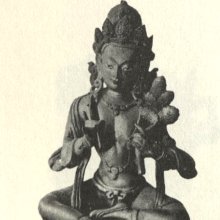Shilaparamita, Śīlapāramitā, Shila-paramita: 5 definitions
Introduction:
Shilaparamita means something in Buddhism, Pali, Hinduism, Sanskrit. If you want to know the exact meaning, history, etymology or English translation of this term then check out the descriptions on this page. Add your comment or reference to a book if you want to contribute to this summary article.
The Sanskrit term Śīlapāramitā can be transliterated into English as Silaparamita or Shilaparamita, using the IAST transliteration scheme (?).
Images (photo gallery)
In Buddhism
Mahayana (major branch of Buddhism)
Source: Wisdom Library: Maha Prajnaparamita SastraŚīlapāramitā (शीलपारमिता) refers to the “virtue of morality” and represents one of the six perfections (pāramitā) according to the 2nd century Mahāprajñāpāramitāśāstra (chapter XXIII).—Some say that the virtue of morality (śīla) is the morality of the bodhisattva who prefers to lose his life rather than break the smallest precept. As was said above in Sutasomarājasūtra, the bodhisattva sacrifices his life to keep the precpts.
How does the Bodhisattva fulfill the virtue of discipline (śīlapāramitā)? Answer: By not sparing his life when it is a question of keeping the pure precepts (viṣuddhaśīla). Thus king Sutasoma, for the sake of the great king Kalmāṣapāda went so far as to offer his life, but did not violate the precepts.
Source: academia.edu: A Study and Translation of the GaganagañjaparipṛcchāŚīlapāramitā (शीलपारमिता) refers to the “perfection of the morality”, according to the Gaganagañjaparipṛcchā: the eighth chapter of the Mahāsaṃnipāta (a collection of Mahāyāna Buddhist Sūtras).—Accordingly, “Then, the Lord went on to speak these verses: ‘[...] (49) With the basis of morality, they reflect on verses supporting liberation. Thus they remain in the way of happiness and liberation as adorned with morality. (50) They are beyond distraction and conceited thoughts by cutting off the afflicted view, and they attain the ultimate perfection after having spread friendliness just as the expense of the sky. (51) Never having abandoned the certainty of reaching awakening, they never make false discrimination of awakening. The wise people who are content in that way attain the perfection of the morality (śīlapāramitā)’”.

Mahayana (महायान, mahāyāna) is a major branch of Buddhism focusing on the path of a Bodhisattva (spiritual aspirants/ enlightened beings). Extant literature is vast and primarely composed in the Sanskrit language. There are many sūtras of which some of the earliest are the various Prajñāpāramitā sūtras.
Tibetan Buddhism (Vajrayana or tantric Buddhism)
Source: archive.org: The Indian Buddhist IconographyŚīlapāramitā (शीलपारमिता) refers to one of twelve Pāramitā Goddesses in human form, as commonly depicted in Buddhist Iconography, and mentioned in the 11th-century Niṣpannayogāvalī of Mahāpaṇḍita Abhayākara.—Her Colour is white; her Symbol is a flowery discus; she has two arms.
Śīlapāramitā is described in the Niṣpannayogāvalī (dharmadhātuvāgīśvara-maṇḍala) as follows:—
“Śīlapāramitā is white in colour and holds in her left hand the discus made of white flowers and leaves”.
[The right hand holds the cintāmaṇi banner as usual. A statuette of this deity occurs in China.
The twelve deities collectively have their spiritual father in Ratnasambhava. [...] According to a statement in the maṇḍala all the deities [viz., Śīlapāramitā] are two-armed, and they hold in the right hand the flag marked with the Cintāmaṇi jewel, and in the left their special symbols. Prajñāpāramitā is an exception since she has two more hands.]

Tibetan Buddhism includes schools such as Nyingma, Kadampa, Kagyu and Gelug. Their primary canon of literature is divided in two broad categories: The Kangyur, which consists of Buddha’s words, and the Tengyur, which includes commentaries from various sources. Esotericism and tantra techniques (vajrayāna) are collected indepently.
General definition (in Buddhism)
Source: Wisdom Library: Dharma-samgrahaŚīlapāramitā (शीलपारमिता) or simply śīla refers to the “perfection of virtue” and represents the second of the “six perferctions” (ṣaṭpāramitā) as defined in the Dharma-saṃgraha (section 17). The Dharma-samgraha (Dharmasangraha) is an extensive glossary of Buddhist technical terms in Sanskrit (e.g., ṣaṣ-pāramitā and śīla-pāramitā). The work is attributed to Nagarjuna who lived around the 2nd century A.D.
Śīlapāramitā forms, besides a part of the “six perferctions” (ṣaṭpāramitā), also a part of the “ten perfections” (daśa-pāramitā).
Languages of India and abroad
Sanskrit dictionary
Source: Cologne Digital Sanskrit Dictionaries: Monier-Williams Sanskrit-English DictionaryŚīlapāramitā (शीलपारमिता):—[=śīla-pāramitā] [from śīla > śīl] f. (with Buddhists) the perfection (called) śīla (one of the 6 transcendental perfections cf. under śīla), [Saddharma-puṇḍarīka; Kāraṇḍa-vyūha]
Sanskrit, also spelled संस्कृतम् (saṃskṛtam), is an ancient language of India commonly seen as the grandmother of the Indo-European language family (even English!). Closely allied with Prakrit and Pali, Sanskrit is more exhaustive in both grammar and terms and has the most extensive collection of literature in the world, greatly surpassing its sister-languages Greek and Latin.
See also (Relevant definitions)
Partial matches: Shila, Paramita, Cila.
Full-text: Shatparamita, Six Perfections, Dashaparamita, Ten Perfections, Devamanusa, Sutasoma, Jatihetu, Silavanaga Jataka, Alinasattu, Shila, Sankhapala Jataka, Campeyya Jataka.
Relevant text
Search found 10 books and stories containing Shilaparamita, Śīlapāramitā, Shila-paramita, Śīla-pāramitā, Silaparamita, Sila-paramita; (plurals include: Shilaparamitas, Śīlapāramitās, paramitas, pāramitās, Silaparamitas). You can also click to the full overview containing English textual excerpts. Below are direct links for the most relevant articles:
Maha Prajnaparamita Sastra (by Gelongma Karma Migme Chödrön)
Part 9 - Fulfilling the perfections skillfully < [Chapter XLIX - The Four Conditions]
Part 2 - Practicing the six perfections < [Chapter XLV - Application of Merit]
Vimalakirti Nirdesa Sutra (by Charles Luk)
Ksitigarbha Bodhisattva fundamental vow sutra (by Johnny Yu)
Prajnaparamita in Buddhist < [November-December 1931]
Vimalakīrti Sutra (by John R. McRae)
Chapter IV - Bodhisattvas < [Fascicle One]
Mahayana Mahaparinirvana Sutra
Chapter XXXVIII - On Bodhisattva Lion's Roar (f) < [Section Seven]
Chapter XXXII - On Bodhisattva Highly-virtuous King (f) < [Section Six]
Chapter XVIII - On Actual Illness < [Section Two]

